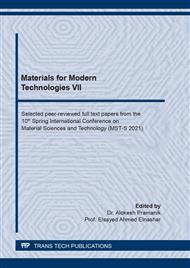[1]
Wang H, Xu J U, Kang Y, et al. Study on inhomogeneous characteristics and optimize homogenization treatment parameter for large size DC ingots of Al-Zn-Mg-Cu alloys[J]. Journal of alloys and compounds, 2014, 585: 19-24.
DOI: 10.1016/j.jallcom.2013.09.139
Google Scholar
[2]
Liu S D, Zhang X M, Chen M A, et al. Influence of aging on quench sensitivity effect of 7055 aluminium alloy[J]. Materials Characterization, 2008, 59(1): 53-60.
DOI: 10.1016/j.matchar.2006.10.019
Google Scholar
[3]
Li J G, Wang S Q. Distortion caused by residual stresses in machining aeronautical aluminium alloy parts: recent advances[J]. The International Journal of Advanced Manufacturing Technology, 2017, 89(1-4): 997-1012.
DOI: 10.1007/s00170-016-9066-6
Google Scholar
[4]
Chobaut N, Carron D, Arsène S, et al. Quench induced residual stress prediction in heat treatable 7xxx aluminium alloy thick plates using Gleeble interrupted quench tests[J]. Journal of Materials Processing Tech., 2015 (222): 373-380.
DOI: 10.1016/j.jmatprotec.2015.03.029
Google Scholar
[5]
Ye S, Chen K, Zhu C, et al. A New Path of Quench-Induced Residual Stress Control in Thick 7050 Aluminium Alloy Plates[J]. Metals, 2019, 9(4): 393.
DOI: 10.3390/met9040393
Google Scholar
[6]
Li L X, Zhou J, Duszczyk J. Prediction of temperature evolution during the extrusion of 7075 aluminium alloy at various ram speeds by means of 3D FEM simulation[J]. Journal of materials processing technology, 2004, 145(3): 360-370.
DOI: 10.1016/j.jmatprotec.2003.09.003
Google Scholar
[7]
Freund S, Pautsch A G, Shedd T A, et al. Local heat transfer coefficients in spray cooling systems measured with temperature oscillation IR thermography[J]. International Journal of Heat and Mass Transfer, 2007, 50(9-10): 1953-1962.
DOI: 10.1016/j.ijheatmasstransfer.2006.09.028
Google Scholar
[8]
Cheng H, Xie J, Li J. Determination of surface heat-transfer coefficients of steel cylinder with phase transformation during gas quenching with high pressures[J]. Computational materials science, 2004, 29(4): 453-458.
DOI: 10.1016/j.commatsci.2003.11.003
Google Scholar
[9]
Robinson J S, Tanner D A, Truman C E. 50th anniversary article: the origin and management of residual stress in heat‐treatable aluminium alloys[J]. Strain, 2014, 50(3): 185-207.
DOI: 10.1111/str.12091
Google Scholar
[10]
Cao H L, Li X W, Li Y N, et al. Numerical simulation of quenching and pre-stretching residual stress in 7085 aluminium alloy plate[C]//Materials Science Forum. Trans Tech Publications Ltd, 2016, 852: 211-217.
DOI: 10.4028/www.scientific.net/msf.852.211
Google Scholar
[11]
Tanner D A, Robinson J S. Modelling stress reduction techniques of cold compression and stretching in wrought aluminium alloy products[J]. Finite elements in analysis and design, 2003, 39(5-6): 369-386.
DOI: 10.1016/s0168-874x(02)00079-3
Google Scholar
[12]
Lavrentyev A I, Stucky P A, Veronesi W A. Feasibility of ultrasonic and eddy current methods for measurement of residual stress in shot peened metals[J]. AIPC, 2000, 19: 1621-1628.
DOI: 10.1063/1.1306227
Google Scholar
[13]
Withers P., Bhadeshia H. Residual stress. Part 1–measurement techniques[J]. Materials Science and Technology, 2001, 17(4): 355-365.
DOI: 10.1179/026708301101509980
Google Scholar
[14]
Prime M B, Hill M R. Residual stress, stress relief, and inhomogeneity in aluminium plate[J]. Scripta Materialia, 2002, 46(1): 77-82.
DOI: 10.1016/s1359-6462(01)01201-5
Google Scholar
[15]
Nervi S., B. A. Szabó. On the estimation of residual stresses by the crack compliance method. Computer methods in applied mechanics and engineering, 2007, 196(37): 3577-3584.
DOI: 10.1016/j.cma.2006.10.037
Google Scholar
[16]
Ersoy N., Vardar O. Measurement of residual stresses in layered composites by compliance method[J]. Journal of Composite Materials, 2000, 34(7): 575-598.
DOI: 10.1177/002199830003400703
Google Scholar


